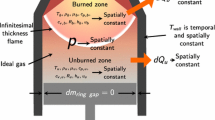Abstract
In this work, we present a method based on a zero-dimensional thermodynamic model for estimating the onset of the knocking phenomena in a flex-fuel engine using gasohol (gasoline blended with anhydrous ethanol) and blends of gasohol with hydrous ethanol. The contents of the combustion chamber are assumed homogeneous and the energy release is modeled by the well-known Wiebe’s equations. Heat loss through the walls of the cylinder is modeled by the Woschni’s equations. The fuel ignition delay is based on an improved empirical Arrhenius model found in the literature, which depends only on the pressure, temperature, fuel–air equivalence ratio, octane number and percentage of ethanol or methanol present in the fuel. A proper scheme for coupling these models is presented, allowing for knocking occurrence estimation. Simulated results are compared with experimental data, showing agreement compatible with the modeling adopted.




Similar content being viewed by others
References
Heywood JB (1988) Internal combustion engine fundamentals. McGraw-Hill
Westbrook CK, Dryer FL (1984) Chemical kinetic modeling of hydrocarbon combustion. Prog Energy Combust Sci 19:1–47
Leppard WR (1985) A detailed chemical kinetics simulation of engine knock. Combust Sci Technol 43:1–20
Pitz WJ, Westbrook CK (1986) Chemical kinetics of the high pressure oxidation of n-butane and its relation to engine knock. Combust Flame 63:113–133
Pearlman H, Chapek RM (1999) Cool flames and autoignition: thermal-ignition theory of combustion experimentally validated in microgravity. Research and Technology—NASA Glenn Research Center, pp 141–142
Chun KM, Heywood JB, Keck JC (1988) Prediction of knock occurrence in a spark-ignition engine. In: Twenty-Second Symposium (International) on Combustion, The Combustion Institute, pp 455–463
Cox RA, Cole JA (1985) Chemical aspects of autoignition of hydrocarbon-air mixtures. Combust Flame 60:109–123
Cowart JS, Keck JC, Heywood JB, Westbrook CK, Pitz WJ (1990) Engine knock predictions using a fully-detailed and a reduced chemical kinetic mechanism. In: Twenty-Third Symposium (International) on Combustion, The Combustion Institute, pp 1055–1062
Moses E, Yarin AL, Bar-Yoseph P (1995) On knocking prediction in spark ignition engines. Combust Flame 101:239–261
Soylu S, Gerpen JV (2003) Development of an autoignition submodel for natural gas engines. Fuel 82:1699–1707
Yates ADB, Viljoen CL (2008) An improved empirical model for describing auto-ignition. SAE Technical Paper 2008-01-1629
Yates ADB, Bell A, Swarts A (2010) Insights relating to the autoignition characteristics of alcohol fuels. Fuel 89:83–93
Melo TCC, Machado GB, Carvalho LO, Belchior CR, Colaço MJ, Barros JEM, Paiva CEF (2012) In cylinder pressure curve and combustion parameters variability with ethanol addition. SAE Technical Paper 2012-36-0486
Melo TCC (2012) Experimental analysis and computational simulation of a flex engine operating with different blends of gasoline and hydrous ethanol, PhD Thesis (in Portuguese), Federal University of Rio de Janeiro, Department of Mechanical Engineering, Brazil
Ramos JI (1989) Internal combustion engine modeling. CRC Press
Colaço MJ, Teixeira CV, Dutra LM (2010) Thermal analysis of a diesel engine operating with diesel-biodiesel blends. Fuel 89:3742–3752
Colaço MJ, Teixeira CV, Dutra LM (2010) Thermodynamic simulation and optimization of diesel engines operating with diesel and biodiesel blends using experimental data. Inverse Problems Sci Eng 18:787–812
Estumano DC, Hamilton FC, Colaço MJ, Leiroz AJK, Orlande HRB, Carvalho RN, Dulikravich GS (2015) Bayesian estimate of mass fraction of burned fuel in internal combustion engines using pressure measurements. In: Rodrigues et al. (eds) Engineering Optimization IV, pp 997–1003
Lanzafame R, Messina M (2005) New gases thermodynamic properties models to predict combustion phenomena. SAE Technical Paper 2005-01-2112
Borman G, Nishiwaki K (1987) Internal combustion engine heat transfer. Prog Energy Combust Sci 13:1–46
Hamilton FC, Colaço MJ, Carvalho RN, Leiroz AJK (2014) Heat transfer coefficient estimation of an internal combustion engine using particle filters. Inverse Problems Sci Eng 22:483–506
Press WH, Teukolsky SA, Vetterling WT, and Flannery, BP (2007) Numerical recipes: the art of scientific computation, 3rd edn, Cambridge University Press
Melo TCC, Machado GB, Belchior CRP, Colaço MJ, Barros JEM, Oliveira EJ, Oliveira DG (2012) hydrous ethanol-gasoline blends—combustion and emission investigations on a flex-fuel engine. Fuel 97:796–804
Acknowledgments
The authors would like to acknowledge the financial support obtained by the following Brazilian agencies: CNPq, CAPES, FAPERJ, ANP/PRH37 (http://prh.mecanica.ufrj.br/).
Author information
Authors and Affiliations
Corresponding author
Additional information
Technical Editor: Francis HR Franca.
Rights and permissions
About this article
Cite this article
Tougri, I., Colaço, M.J., Leiroz, A.J.K. et al. Knocking prediction in internal combustion engines via thermodynamic modeling: preliminary results and comparison with experimental data. J Braz. Soc. Mech. Sci. Eng. 39, 321–327 (2017). https://doi.org/10.1007/s40430-016-0519-5
Received:
Accepted:
Published:
Issue Date:
DOI: https://doi.org/10.1007/s40430-016-0519-5




